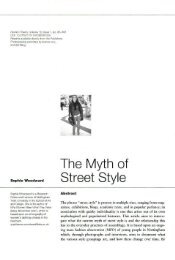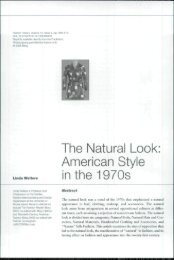Spinning the Ephemeral PDF - SMU Fashion Media
Spinning the Ephemeral PDF - SMU Fashion Media
Spinning the Ephemeral PDF - SMU Fashion Media
Create successful ePaper yourself
Turn your PDF publications into a flip-book with our unique Google optimized e-Paper software.
292 Fiona Anderson<br />
orange, provided subtle surface interest, ra<strong>the</strong>r than a stridently colored<br />
cloth overall (Gulvin 1973: 76). Also, <strong>the</strong> description of <strong>the</strong> Cheviots as<br />
"mostly plain" suggests that <strong>the</strong>y were primarily intended to be wotn in<br />
urban settings.<br />
These references to <strong>the</strong> Scottish landscape might be seen panly as sales<br />
talk that had an imaginative resonance, within <strong>the</strong> textiles and tailoring<br />
trades and ultimately with male consumers. It also refers to a measure of<br />
genuine influence of rural landscapes and contexts on tweed designs. For<br />
example, <strong>the</strong> predominant account given for <strong>the</strong> development of many<br />
tweed designs is that <strong>the</strong>y evolved from <strong>the</strong> black-and-white plaids worn<br />
by shepherds in <strong>the</strong> Scottish Borders (Ponting 1987: 78-80). In particular<br />
that simple design in a twill weave has been seen as <strong>the</strong> basis for a group<br />
of tweeds known as estate tweeds, or by <strong>the</strong> alternative name of district<br />
checks. These tweeds first developed in <strong>the</strong> 1840s linked to <strong>the</strong> desires of<br />
landowners to create a specific identity for <strong>the</strong>ir estate. One of <strong>the</strong> earliest<br />
estate tweeds was <strong>the</strong> Clenurquart, which was adopted by Caroline,<br />
Countess of Seafield on her estates from <strong>the</strong> 1840s onwards. This black<br />
and white check with <strong>the</strong> addition of a blue or red over check has widely<br />
and erroneously been known as <strong>the</strong> Prince of Wales check. It is one of<br />
<strong>the</strong> few seminal textile patterns that have remained popular in men's and<br />
women's clothing since <strong>the</strong> nineteenth century. The Glenurquart, like<br />
many of <strong>the</strong> estate tweeds, has constantly been adapted by manufacturers<br />
to form ei<strong>the</strong>r new estate tweeds or commercially available designs<br />
(Harrison 1968, 1995).<br />
The emergence of estate tweeds was intrinsically linked to major<br />
economic and social changes within <strong>the</strong> Scottish Highlands. By <strong>the</strong> late<br />
nineteenth century <strong>the</strong> Highlands of Scotland had largely been converted<br />
into a series of private sporting estates and a minority of local people had<br />
taken on new occupations as ghillies, keepers, stalkers, and pony-men,<br />
outdoor servants who had skills and knowledge about <strong>the</strong> local terrain<br />
and animal life that was essential to those who wanted to partake in sports<br />
such as deer-stalking, grouse shooting, and salmon fishing (Dossena 2000;<br />
Mackenzie 1998: 28). Several landowners thought it necessary to create<br />
a livery for <strong>the</strong>se servants, one that was distinctive enough to signal <strong>the</strong>ir<br />
connection to a specific tract of private land but that also provided a<br />
degree of protection both from <strong>the</strong> elements and also <strong>the</strong> watchful eyes<br />
of animals who were to be stalked as prey. Stiliie notes <strong>the</strong> connections<br />
with romantic perceptions of <strong>the</strong> previous clan system whereby:<br />
many of <strong>the</strong> new landowners and tenants did not have claim to a<br />
tartan but wished some distinctive garb for <strong>the</strong>mselves and <strong>the</strong>ir<br />
estate workers. It was in this environment that <strong>the</strong> cloths which later<br />
became known as <strong>the</strong> District checks developed; <strong>the</strong> name tends to<br />
be misleading as <strong>the</strong> cloths were attached to some estate., organization<br />
or regiment ra<strong>the</strong>r than a district (Stiliie 1970: 328).




